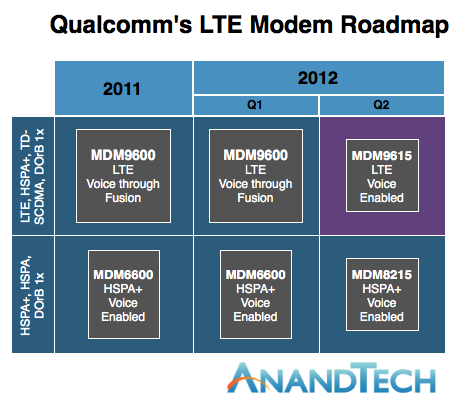Along the road leading up to today's iPhone 4S reveal were many rumors about the iPhone 5 coming out this year boasting a new thinner, teardrop profile - potentially even with LTE. Despite attempts to convince people otherwise, magic doesn't actually exist and fitting the existing 45nm iPhone 4 internals (not to mention a larger, more power hungry 45nm A5 SoC) in a significantly smaller chassis with no impact on battery life isn't really possible.
The iPhone 4 PCB is already incredibly small, not leaving any room for an extra chip to enable LTE without shrinking the size of the battery (or increasing the thickness of the phone to accomodate both a larger PCB and a big battery). Today, Qualcomm is a leading provider of LTE baseband silicon and unfortunately they don't ship any baseband hardware that supports both LTE and voice (over 1x/WCDMA) without extra silicon. In order to support both you need to be using something Qualcomm calls SoC Fusion. By leveraging a Qualcomm Snapdragon SoC in combination with Qualcomm's MDM9600 LTE modem you can deliver both voice and LTE data. Otherwise the MDM9600 is only good for data, which is admittedly useful in things like USB modems or MiFis. Apple obviously doesn't use Qualcomm Snapdragon SoCs so enabling LTE on the iPhone isn't possible using Qualcomm baseband unless you make the phone's PCB larger (which Apple obviously wasn't going to do). Note that no one else seems to deliver a single chip LTE + 1x/WCDMA voice solution either, so this isn't just a Qualcomm limitation.

While the MDM9600 is built on a 45nm process, its successor due in 2012 is built on a 28nm process. Qualcomm's current roadmaps show the 28nm MDM9615 arriving in Q2 2012. The 9615 finds itself in a smaller 10x10mm package and is voice enabled as well. Apple (and all other smartphone makers) could replace the MDM6600 with the MDM9615 and have a "single chip" LTE solution for smartphones. I put single chip in quotes because there are obviously other components necessary such as a PMIC and in the case of the MDM9615, an external transceiver. But next year (Q2 to be exact) should be when we can finally get LTE into something iPhone-sized.
These modems are pretty power hungry DSPs, the move to 28nm should not only help reduce die size and allow for more integration but it should also decrease power consumption. Phones based on the MDM9615 will likely increase LTE battery life to reasonable levels rather than what we've seen from the first generation of devices.
As you may have heard however, the move to 28nm at both TSMC and Global Foundries isn't really going all that smoothly. The jump from 4x-nm to 28nm is a very big one, so it's not unexpected to have pretty serious teething problems as the process ramps up. I suspect that an aggressive 28nm roadmap that didn't pan out probably caught a lot of SoC and smartphone vendors in a position where they couldn't ship what they wanted to in 2011.
If you're waiting for an LTE enabled iPhone 5 (or just better battery life out of an LTE smartphone), you'll have to wait until late Q2 next year at the earliest. While I don't like participating in the rumor garbage, if I were to guess at the release date of the rumored iPhone 5 I'd say early Q3 2012.
]]>
0 comments:
Post a Comment